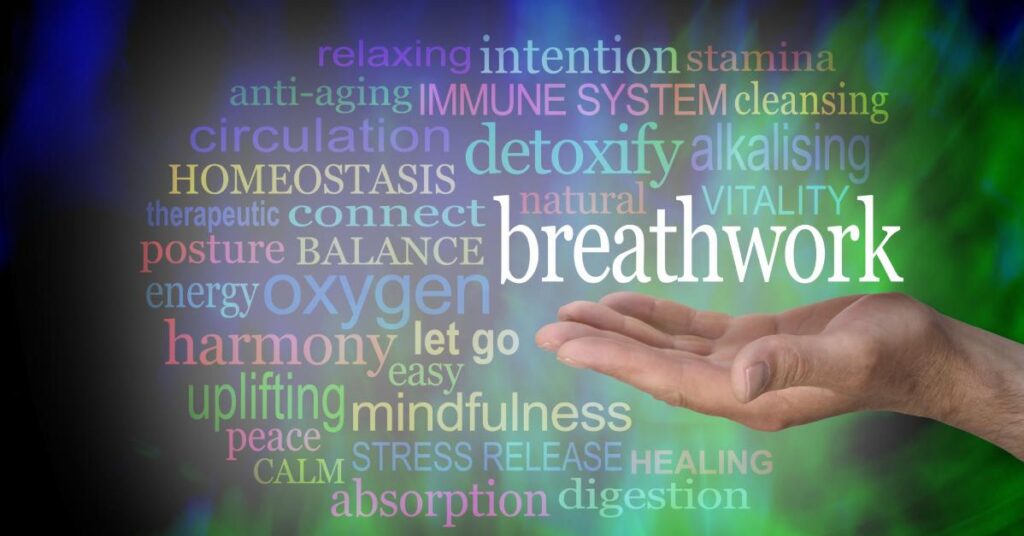Breathing exercises serve as effective tools for stress reduction and relaxation enhancement. These techniques, including Belly Breathing, Pursed Lip Breathing, and Box Breathing (among others), focus on deepening and regulating breaths, activating the body’s parasympathetic nervous system. This activation diminishes the ‘fight or flight’ response, fostering calmness, improving oxygen intake, and enhancing stress resilience.
The discussed techniques—Belly Breathing, Pursed Lip Breathing, Box Breathing, Lion’s Breath, and Alternate Nostril Breathing—each play a specific role in stress management and emotional well-being.
Key Takeaways:
- Breathing exercises influence the autonomic nervous system and physiologically influence the body;
- Breathwork can reduce stress, inflammation, and chronic pains;
- Breathing meditation is an effortless way to clear one’s mind and improve mental clarity.
Table of Contents
Why Breathing Exercises Help?

Breathing exercises are increasingly recognized for their versatile health benefits, particularly in the management of mental health conditions such as anxiety and depression.
These techniques also play a significant role in respiratory care, enhancing lung function and aiding in the treatment of ailments like pneumonia and COPD.
This discussion will explore how structured breathing practices contribute to both psychological and physiological well-being.
Can Breathing Exercises Help with Anxiety?
Breathing exercises reduce anxiety symptoms by slowing breath rate and activating the parasympathetic nervous system. Techniques like diaphragmatic breathing counter the sympathetic nervous system’s ‘fight or flight‘ response, prevalent in anxious individuals.
Controlled breathing patterns induce calmness, easing immediate anxiety symptoms. Regular practice enhances stress resilience, establishing breathing exercises as effective tools for anxiety management.
Can Breathing Exercises Help with Depression?
Breathing exercises aid in depression management by promoting relaxation and reducing stress hormones. These techniques, effective in enhancing mood, involve slow, deep inhalations that increase oxygen supply to the brain and stimulate the parasympathetic nervous system, leading to calmness. Consistent practice of these exercises can improve emotional regulation and reduce depression symptoms.
As a self-help approach, breathing exercises empower individuals to proactively manage their mental health.
Are Breathing Exercises Good for Your Lungs?
Breathing exercises enhance lung function, increase respiratory muscle strength, and improve airway clearance. These exercises, crucial for respiratory health, optimize both oxygen uptake and carbon dioxide expulsion.
- Diaphragmatic Breathing: This technique, often practiced in yoga and meditation, targets the diaphragm, enhancing lung volume and facilitating deeper breathing.
- Pursed Lip Breathing: Common in pulmonary rehabilitation, this method helps control breathing patterns, promoting slower and more effective breaths, which improves respiratory endurance.
- Alternate Nostril Breathing: A technique from yoga that balances respiratory pathways, ensuring equal airflow in both nostrils, thus supporting overall respiratory symmetry and efficiency.
Regular practice of these techniques contributes to the robustness of respiratory functions, aiding in the maintenance of efficient lung health.
Do Breathing Exercises Help with Pneumonia and COPD?
Breathing exercises enhance lung function and reduce symptoms in individuals with pneumonia and COPD. Techniques such as diaphragmatic breathing and pursed-lip breathing improve ventilation, assist in clearing airway secretions, and optimize oxygen exchange efficiency.
These exercises strengthen respiratory muscles, helping to alleviate breathlessness and boost respiratory endurance. In the context of chronic obstructive pulmonary disease (COPD), these practices are crucial for managing disease symptoms. For pneumonia, they aid in recovery by promoting increased lung capacity and resilience.
Regular engagement in these exercises significantly enhances daily functioning and overall quality of life, establishing them as essential elements in the treatment and management of these respiratory conditions.
How Breathing Exercises Help – A Physiological Perspective

Breathing exercises impact the balance of oxygen and carbon dioxide in the body, crucial for peak physiological function.
By stimulating the parasympathetic nervous system and activating the vagus nerve, these exercises promote relaxation and reduce stress responses.
Regular practice can also help regulate blood pressure, enhancing overall cardiovascular health.
Oxygen and Carbon Dioxide
Proper breathing techniques enhance oxygen supply, benefiting brain function and organ health. These techniques also regulate carbon dioxide levels, maintaining blood pH balance essential for bodily functions.
Increased oxygen supply boosts energy and mental clarity, while controlled carbon dioxide expulsion supports metabolic efficiency and nervous system calmness. Enhanced oxygenation aids in cellular waste removal and strengthens the immune system, promoting overall health.
Parasympathetic Nervous System and Vagus Nerve
Controlled breathing enhances oxygen and carbon dioxide regulation, directly impacting the parasympathetic nervous system and vagus nerve stimulation.
Deep, slow respiratory exercises activate the vagus nerve, extending from the brainstem to the abdomen, crucial for initiating the parasympathetic response—characterized as the ‘rest and digest’ system. This activation results in decreased heart rate and reduced muscle tension, fostering relaxation and calmness throughout the body.
Such physiological changes contribute to stress reduction, cardiovascular health improvement, and mood stabilization, exemplifying the significant link between respiratory management and autonomic nervous system functioning.
Breathing Exercises and Blood Pressure
Breathing exercises effectively lower blood pressure by activating the body’s parasympathetic nervous system, decreasing stress hormones, enhancing oxygen intake, and promoting vascular health.
- Activation of Parasympathetic Nervous System: Slow, deliberate breathing increases parasympathetic response, reducing heart rate and dilating blood vessels, thereby decreasing blood pressure.
- Reduction of Stress Hormones: Engaging in routine breathing practices curtails the production of cortisol and other stress-related hormones, contributing to lower blood pressure levels.
- Enhancement of Oxygen Exchange: Proper breathing techniques improve oxygen uptake, essential for regulating and maintaining optimal blood pressure.
- Promotion of Vascular Health: Deep breathing exercises foster better blood circulation, supporting vascular system integrity and lowering overall blood pressure.
These methods underscore the importance of respiratory control in managing and optimizing cardiovascular functions and stress responses.
Summary: Deep Breathing Health Benefits
The practice of breath work, particularly simple breathing exercises, has been scrutinized by academic research institutions globally. The findings from multiple peer-reviewed studies emphasize its efficacy in enhancing the overall well-being of both body and mind. When individuals practice deep breathing, they breathe in slowly to fill their lungs entirely, which has been proven to significantly help reduce levels of stress and anxiety. This technique ensures that oxygen is efficiently distributed throughout your body, promoting a state of peace and calm.
Deep breathing exercises facilitate in mitigating tension and anxiety, thereby acting as a natural stressor reliever. When you feel short of breath or overwhelmed, taking the time to normal the breathing rate can drastically relieve these feelings of discomfort. Such practices are often endorsed by respiratory therapists who acknowledge the significant benefits they have on reducing high blood pressure and improving the response to stress. By guiding air alternately through the left nostril and then right nostril (as in Nadi Shodhana Pranayama), for instance, practitioners feel calmer and less afflicted by the day’s stressors, making it easier to relax.
In addition to that, by enabling your body to shift away from the fight-or-flight reaction and towards a rest-and-digest state, deep breathing exercises helps you relax deeply. This transition is critical for those seeking ways to relieve stress effectively and bring a sense of peace and calm in their daily lives. As a result, individuals who regularly practice deep breathing report an enhanced ability to manage stress and feel more resilient against daily pressures – it all helps lead a healthier and more balanced life.
Breath Focus

In exploring the technique of Breath Focus, we first consider how to effectively connect with your breath. This foundational step involves recognizing and tuning into each inhalation and exhalation to foster a deeper connection with the present moment.
Subsequently, learning controlled breathing is essential for managing stress levels, involving specific strategies to regulate breath pace and depth deliberately.
How to Connect with Your Breath?
To practice breath focus, select a tranquil location to sit or recline, ensuring minimal disturbance. Closing one’s eyes reduces sensory input, enhancing concentration on respiration.
Initially, observe the breath’s natural rhythm without alteration, noting its spontaneous flow. Awareness should encompass sensations linked with the inhalation and exhalation through the nostrils or mouth and the corresponding movement of the chest or abdomen.
This method develops mindfulness by deepening the connection to respiratory patterns and cultivating controlled breathing techniques.
How to Learn Controlled Breathing?
Controlled breathing, a technique for regulating breath pace and depth, enhances both mental and physical wellbeing. Known also as ‘breath focus,’ this method transitions practitioners from shallow, automatic breathing to intentional, deep breaths. It centers on the airflow through the nostrils, abdominal expansion, and the rhythm of inhaling and exhaling, promoting mindfulness and respiratory efficiency.
| Stage | Focus Area | Primary Function |
|---|---|---|
| 1 | Inhalation | Augments oxygen intake |
| 2 | Short hold | Enhances oxygen absorption |
| 3 | Exhalation | Facilitates toxin elimination |
Adopting these stages in daily routines fosters long-term enhancement of mental and physical health through breath focus.
5 Breathing Exercises for Stress Relief

Breathing exercises are recognized for their efficacy in mitigating stress and enhancing relaxation. Techniques such as Belly Breathing, Pursed Lip Breathing, and Box Breathing are simple yet powerful methods that can be practiced by anyone seeking immediate stress relief.
Additionally, more dynamic exercises like Lion’s Breath and Alternate Nostril Breathing reduce anxiety and improve respiratory and mental health.
Belly Breathing (Diaphragmic Breathing)
Belly breathing, termed diaphragmatic breathing, enhances relaxation, alleviates stress, and improves oxygen circulation by engaging the diaphragm to allow full lung expansion and increased breath efficiency. This technique, beneficial for both immediate and long-term stress mitigation, involves several steps for effective practice.
- Positioning: The individual either lies down or sits comfortably, placing one hand on the abdomen.
- Inhalation: Slow intake of air through the nostrils causes the stomach to rise, indicating proper diaphragmatic activation.
- Breath retention: The individual holds the air briefly, enhancing the oxygen exchange.
- Exhalation: Air is released slowly through the lips as the abdominal area naturally contracts.
Consistent practice of belly breathing fosters mindfulness, reduces stress-related physiological responses, and promotes overall well-being. This method, rooted in respiratory techniques, offers a practical approach to managing physical and psychological stress through controlled breathing patterns.
Pursed Lip Breathing
Pursed lip breathing is a breathing technique that reduces shortness of breath and stress effects. Participants inhale slowly through the nose and exhale gently through pursed lips, mimicking candle blowing, with the exhalation lasting twice as long as inhalation.
This method prolongs airway openness, enhances gas exchange in the lungs, and improves blood oxygenation. Regular application of pursed lip breathing decreases breathlessness, increases relaxation, and stabilizes stress responses.
Beneficial for individuals with respiratory conditions such as COPD or asthma and those seeking stress reduction, pursed lip breathing supports pulmonary function and psychological well-being.
Box Breathing (Square Breathing)
Box breathing, also termed square breathing, is a relaxation technique that optimizes autonomic nervous system function, mitigates stress, and diminishes anxiety through controlled respiratory actions. This technique comprises four main phases:
- Inhalation: Participant inhales through the nostrils for a duration of four seconds, ensuring the lungs are fully expanded with air.
- Breath Retention: Air is held within the lungs for four seconds, facilitating optimal oxygen distribution throughout the bloodstream.
- Exhalation: Breath is expelled through the mouth over a four-second period, ensuring complete air evacuation from the lungs.
- Pause: A four-second pause ensues, maintaining a steady respiratory cycle before repetition.
The structured and equal time intervals for each phase of Box breathing aid in fostering mental clarity and enhancing concentration.
Lion’s Breath
Lion’s Breath is a pranayama-derived breathing exercise that effectively reduces tension and stress. It involves deep inhalation through the nostrils and forceful exhalation through the mouth with an extended tongue, resembling a lion’s roar. This practice enhances mental clarity and invigorates the body, promoting relaxation in facial and jaw muscles.
Regular practitioners often experience empowerment and substantial stress relief from Lion’s Breath. This makes it beneficial for daily stress management and overall well-being improvement.
Alternate Nostril Breathing
Alternate Nostril Breathing, termed Nadi Shodhana in traditional yoga, alternates airflow between nostrils to enhance physiological and psychological balance. This technique synchronizes cerebral hemispheres, enhancing mental clarity and tranquility.
Key benefits include:
- Respiratory Health Improvement: Consistent practice increases pulmonary capacity and endurance.
- Autonomic Nervous System Equilibrium: Regular application stabilizes sympathetic and parasympathetic responses, facilitating stress reduction and relaxation.
- Cognitive Enhancement: Focused breathing during this exercise sharpens mental concentration.
- Emotional Regulation: This practice diminishes anxiety and fosters a calm mental state, crucial for emotional stability.
Practicing Breathing Exercises with a Coach

Engaging a skilled coach enhances breathing exercise effectiveness, particularly in stress management and well-being improvement. Coaches, knowledgeable in both physiological and psychological facets of breathing, customize techniques for individuals based on specific conditions like anxiety, chronic stress, or respiratory issues, ensuring proper execution to maximize benefits and minimize risks.
They apply diverse methodologies, including pranayama from yoga and coherent breathing techniques, tailored to client goals and health status. Regular practice, facilitated by a coach’s guidance, proves crucial for sustained stress relief and mental health maintenance.
The coach’s supportive presence motivates individuals, fostering commitment and consistency in practice, which leads to enhanced stress reduction and emotional resilience. Thus, coaching provides a structured, informed, and motivational framework, amplifying breathwork benefits for managing stress.
Want to learn breathing meditation techniques from an experienced coach? Click the button below to apply to my 1-on-1 coaching program!
Conclusion: Breathing Exercises for Stress Management

Breathing exercises, derived from both ancient practices and modern therapies, serve as effective tools for stress reduction and physiological health enhancement. These techniques improve respiratory function, mental clarity, and emotional stability, confirmed by empirical studies demonstrating their effectiveness. Regular use of these methods in clinical and everyday contexts can significantly enhance long-term wellness and aid in managing stress efficiently.
Can breathing exercises replace medication for stress management?
Breathing exercises can alleviate stress, yet they should not replace medication without healthcare professional consultation. These exercises may complement treatments in mild stress cases, but seeking medical advice remains crucial.
Are there risks in practicing breathing exercises incorrectly?
Incorrect practice of breathing exercises can result in increased anxiety, dizziness, or hyperventilation. Proper technique, learned under professional guidance, is crucial to avoid these adverse effects and to secure the intended health benefits.
How quickly can I feel the effects of breathing exercises?
Breathing exercises affect individuals differently; some experience immediate effects, while others may need consistent practice, spanning days to weeks, to observe notable physiological or psychological changes. This variance is due to differences in individual responsiveness and practice consistency.
Can children practice breathing exercises for stress?
Children can engage in breathing exercises, often integrated into yoga and mindfulness programs tailored for different ages. These practices promote physical and emotional health in children.
Is it safe to practice breathing exercises while pregnant?
Breathing exercises, when practiced during pregnancy, are typically safe and potentially beneficial. It is recommended that individuals consult a healthcare provider before initiating any new exercise routines during pregnancy.




